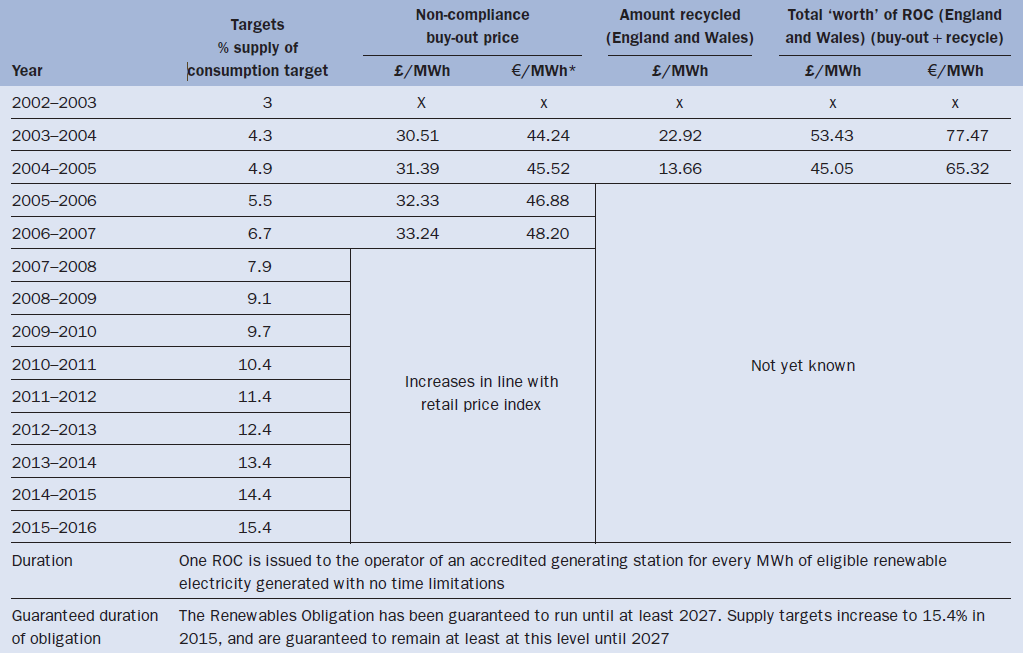MAIN PUBLICATION :
| Home » APPENDIX » Appendix I » United Kingdom |

|
United Kingdom
MARKET STRUCTURE
In the UK, renewable energies are an important part of the climate change strategy and are strongly supported by a green certificate system (with an obligation on suppliers to purchase a certain percentage of electricity from renewable energy sources) and several grants programmes. Progress towards meeting the target has been significant (electricity generation from renewable energies increased by around 70 per cent between 2000 and 2005), although there is still some way to go to meet the 2010 target. Growth has been mainly driven by the development of significant wind energy capacity, including offshore wind farms.
KEY SUPPORT SCHEMES
The UK’s policy regarding renewable energy sources consists of four key strands:
- Obligatory targets with tradable green certificate (ROC) system (a renewables obligation on all electricity suppliers in Great Britain). The non-compliance ‘buy-out’ price for 2006/2007 was set at £33.24/MWh (approx. €48.20/MWh), which will be annually adjusted in line with the retail price index.
- The climate change levy: RES-E is exempt from the climate change levy on electricity of £4.3/MWh (approx. €6.3/MWh)
- Grants schemes: funds are reserved from the New Opportunities Fund for new capital grants for investments in energy crops/biomass power generation (at least £33 million or €53 million over three years), for small-scale biomass/CHP heating (£3 million or €5 million), and planting grants for energy crops (£29 million or €46 million for a period of seven years). A £50 million (€72.5 million) fund, the Marine Renewables Deployment Fund, is available for the development of wave and tidal power.
- Development of a regional strategic approach for planning/targets for renewable energies.
Annual compliance periods run from 1 April one year to 31 March the following year. ROC auctions are held quarterly. In the April 2006 auction over 261,000 ROCs were purchased at an average price of £40.65 (the lowest price for any lot was £40.60).
The following limits have been placed on biomass co-firing within the ROC:
- In the 2009–2010 compliance period, a minimum of 25 per cent of co-fired biomass must be energy crops;
- In 2010–2011, a minimum of 50 per cent of co-fired biomass must be energy crops;
- In 2011–2016, a minimum of 75 per cent of co-fired biomass must be energy crops; and
- After 2016, co-firing will not be eligible for ROCs.
Table I.23: Fixed and Premium FITs in Spain

FUTURE TARGETS
The RES-E target to be achieved by the UK in 2010 is 10 per cent of gross electricity consumption. An indicative target of 20 per cent for RES-E for 2020 has been set. After a relatively stable share in the early 2000s, growth over the past couple of years has been significant. In 2005, the share of renewable sources in electricity generation reached 4.1 per cent.
| Acknowledgements | Sitemap | Partners | Disclaimer | Contact | ||
|
coordinated by  |
supported by  |
The sole responsibility for the content of this webpage lies with the authors. It does not necessarily reflect the opinion of the European Communities. The European Commission is not responsible for any use that maybe made of the information contained therein. |
